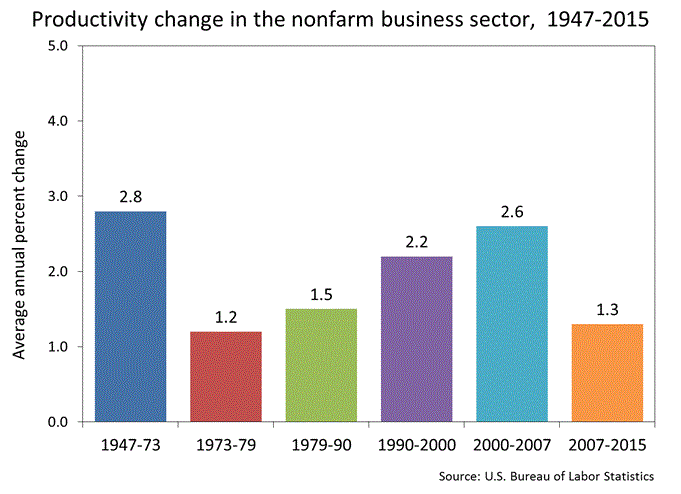U.S. workers produced less per hour for the third consecutive quarter, according to the Labor Department. For the quarter from April through June, hourly output per worker declined by 0.5%. From January through March productivity declined 0.6%.
It’s the longest decline in productivity since 1979, and that is worrying economists who aren’t sure just what is going on. What they do agree on is that if the trend continues, it could prompt companies to cut back on their hiring. Another consequence of stagnant or negative productivity growth is to hold down wages.
Deutsche Bank’s Chief Economist Joseph LaVorgna told The New York Times, “The reason the economy has still been able to expand is because of labor input. Firms are hiring people at a reasonably healthy rate.
“However, we do not believe this can last, because strong hiring in the face of weak productivity necessarily implies a further deterioration in corporate profit margins.”
Is it real or just bad measuring?
Some economists question whether the data is reliable.
“Are we just about running in place or is the radar that measures growth malfunctioning? It’s both. Productivity growth is understated. Economists are just unsure by how much,” said Patrick Newport, a U.S. economist at IHS Global Insight.
But a contrary view was presented in a report detailed in the June Digest of the National Bureau of Economic Research. The research report by Chad Syverson, economics professor at the University of Chicago, argues that the productivity slowdown is real and not a result of mismeasurement primarily of the digital economy.
Says the Digest article, “Syverson concludes that the productivity slowdown likely reflects a real change in the rate of economic progress.”
Innovation is slowing
If the slowdown is real, the cause, says economist Robert Gordon of Northwestern University, is the lack of significant technological advances and damped down business investment in new tools Workers aren’t slacking off, he says. It’s their equipment and the last century business practices.
“In much of the economy,” Gordon told The Atlantic, “daily practices of business methods are not being influenced by the recent innovations in terms of robots, smartphones, or the other things that have happened more recently.”
A gloomier version of Gordon’s views appears in The New Yorker, where writer John Cassidy details the three most common explanations for the productivity slowdown. Mismeasurement, a hesitancy of business to spend on technology, and Gordon’s theory that productivity-enhancing developments are more incremental than revolutionary, may all be at least somewhat correct, says Cassidy.
The role HR can play
Regardless of which explanation is correct — or even if all of them play a part — the slowdown is affecting not only the U.S. but all the advanced economies of the world. And whether more mirage than real, the impact on hiring, comp, benefits and company culture could be significant. Curtailing pay increases has ramifications for hiring and retention, while pressuring line managers to improve productivity can backfire as stressed workers disengage.
Human resources, however, has a role in working with business leadership to grow productivity. Improving engagement has been shown to lead to more productive workers, so demonstrating the relationship to senior management may be HR’s greatest contribution. Another important focus is on helping managers to be better managers, showing them ways they can be more efficient and how to improve the performance of their team by providing more frequent and positive feedback.
A Willis Towers Watson blog post on productivity observed, “Success will depend on collaboration among HR, finance, business and operational leaders to identify appropriate measures, understand related roles and implement interventions.”
